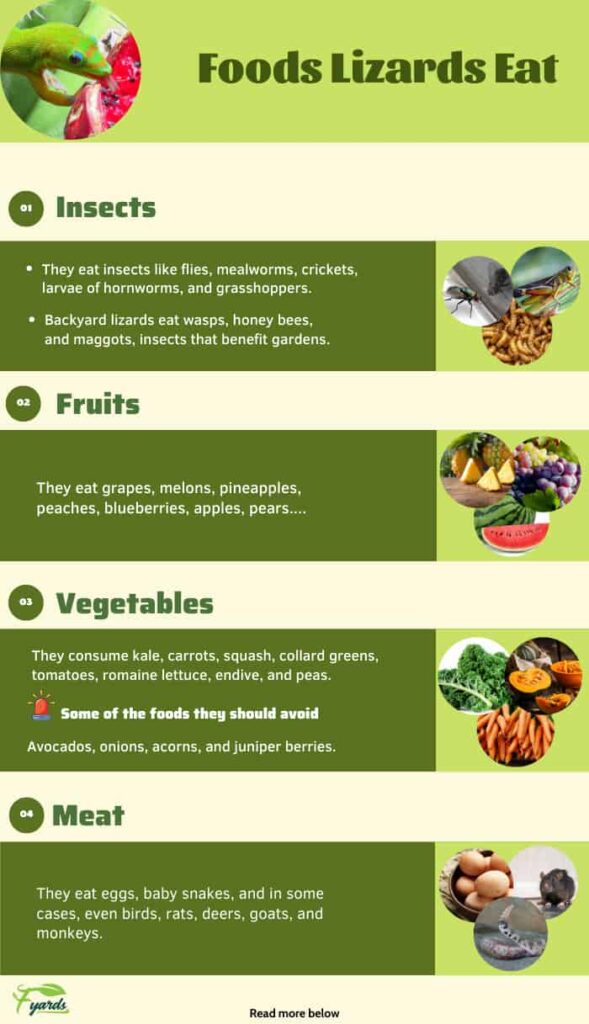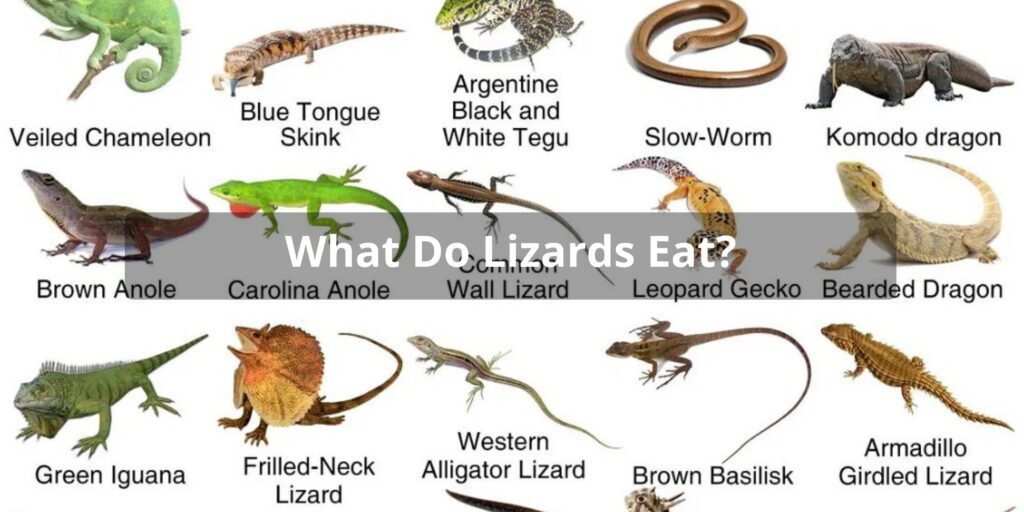Lizards are fascinating animals, and that extends to their eating habits. Watching them focus on their prey, then go incredibly still until…their tongue shoots out of their mouth, dragging that hapless animal to its doom.
However, given that these animals are so furtive, most people never see what it is they’re eating. Bugs? Worms? Jolly Ranchers?
Regardless of whether you’re interested in a lizard’s diet out of sheer curiosity or because you’re thinking of getting one as a pet, learning about how these strange little animals eat is both fun and educational, so strap in.
What Lizards Eat in the Wild
As mentioned above, a lizard’s diet in the wild will be largely dictated by its natural habitat — that is to say, it’ll eat what’s available to them.
More often than not, what’s available is insects. Lots and lots of insects. They’ll also steal eggs if given the chance, as eggs require little effort to hunt, given that they don’t run very fast.
The specific type of insect that the lizard eats will depend on their size. Most lizards eat crickets, grasshoppers, locusts, and similar bugs, but some will also eat larger prey like scorpions and spiders. However, smaller lizards are more likely to be prey than predator to those insects.
Larger lizards have been known to eat injured birds and other lizards as well. At the most extreme end of the spectrum, you’ll find Komodo dragons, which can eat water buffalo, pigs, and even humans. These lizards often consume 80% of their body weight in a single sitting, and since they can weigh as much as 150 pounds, that’s a lot of meat to hunt down.
Lizards don’t always eat meat, though. Some lizards also eat fruit and vegetables, with small berries being a particular favorite. Lizards that live in aquatic habitats will also eat algae, although this is usually only done in a pinch.
What Lizards Eat as Pets
We’re assuming that you’re not planning on owning a Komodo dragon, so there’s no need to track down a water buffalo or an unruly child to feed your lizard. Most lizards that are kept as pets are geckos, iguanas, or chameleons, so we’ll largely focus on them.
A lizard that’s kept as a pet will eat most of the same things they’d eat in the wild — or they should, anyway. The biggest difference is they won’t have to hunt very hard for their prey, as it will be hand-delivered to them (thanks for that, by the way).
One of the biggest things that will determine a captive lizard’s diet is how easy their prey is to procure. Crickets are sold at most pet food stores, so they’ll generally make up the bulk of a pet lizard’s diet. You can always supplement with insects you catch yourself, and this can add some much-needed variety to your lizard’s diet, but check that whatever you caught is suitable for your pet before offering it to them.
Other options include mealworms, Dubai roaches, and wingless fruit flies. Some larger lizards also eat small mice, but many pet stores won’t sell live rodents as feeder animals, so you’d have to convince your reptile to eat a frozen one instead. You can also give your lizard fruits and plants, but these should be in addition to the protein sources listed above, rather than in place of them.
If the thought of feeding your lizard another living thing creeps you out, there are a few species that eat plants and fruit almost exclusively. These include green iguanas, Uromastyx, and Solomon Island skinks. These lizards eat leafy green vegetables, squash, peaches, bananas, and more.
How to Feed a Pet Lizard

It may seem that feeding a lizard is as simple as dumping some bugs in their tank, and in some cases, that’s true. However, it’s not so easy with other species.
Many lizards see their metabolism slow down at night, rendering them sluggish and unresponsive. If there are still uneaten insects in their tank at this time, those bugs could attack and injure them. As a result, it’s generally recommended to remove any live bugs before nightfall and serve them again the next day.
On the other hand, some species are nocturnal, in which case you should do the exact opposite. Do specific research on whichever species you bring home so that you know when to feed them.
If you’re feeding your lizard fruits or vegetables, you should remove uneaten food before it goes bad and starts to mold. Also, be sure to keep it in a bowl or similar container so that your lizard doesn’t eat some of their substrate along with their salad.
Owners of larger lizards like monitors or tegus may want to give their pet mice to eat. If so, your best bet is to buy pre-killed frozen mice rather than tossing live creatures in the tank. Not only is this more humane, but it also reduces the risk the mice will harm your lizard. Simply defrost the mice in warm water before offering them to your pet.
What Do Lizards Eat By English?
Lizards are primarily insectivores, meaning they eat insects like crickets, grasshoppers, locusts, spiders, and more. The specific insects depend on the lizard’s size – smaller lizards eat tiny bugs like ants while large lizards like Komodo dragons can eat bigger prey including pigs, deer, and water buffalo.
Some lizards supplement their diet with eggs, small vertebrates like birds or other lizards, and even fruit and vegetation. Pet lizards typically eat crickets, mealworms, roaches, and other feeder insects. Herbivorous lizards can be fed leafy greens, vegetables, and fruits. It’s important to research the specific dietary needs of your lizard species.
In summary, most lizards are insectivores but some also eat small animals, eggs, fruits, and plants depending on their size and habitat. Pet lizards’ diets aim to mimic their wild counterparts but with easily acquired feeder insects and produce.
Conclusion
Most lizards are opportunistic predators that eat a wide variety of small prey. Insects make up the bulk of their diet, but they will also consume eggs, small vertebrates, vegetation, and even carrion if given the chance. The specific components depend largely on the lizard’s size and habitat.
Pet lizards can be fed feeder insects like crickets purchased from pet stores, supplemented with hand-caught insects. Herbivorous species thrive on a diet of fresh fruits and vegetables. Careful research into your particular lizard’s needs is important for their health.
Overall, lizards make fascinating pets, and it’s endlessly entertaining to watch them stalk and consume their prey. Their unique diets are one of the things that make them so interesting to observe and care for
FAQs About What Do Lizards Eat
How often should I feed my pet lizard?
Lizard feeding frequency varies by species. Generally, adult lizards are fed 2-3 times weekly, while juveniles eat daily. Monitor your pet’s appetite and body condition to adjust accordingly.
What insects are suitable for lizard diets?
Lizards thrive on a diet of crickets, mealworms, waxworms, and roaches. The size of the prey should match the lizard’s head width to prevent choking.
Are there any specific dietary requirements?
Yes, lizard diets vary. Herbivores need leafy greens and fruits, while insectivores require live insects. Omnivores benefit from a mix of both, ensuring essential nutrients.
Can lizards consume commercially-made food?
Yes, many commercial diets offer balanced nutrition. However, live insects should remain a significant part of the diet for most lizards, as they mimic natural feeding behaviors.
What are the signs of an unhealthy diet?
Unhealthy diet signs include weight loss, lethargy, irregular shedding, and dull skin color. Consult a veterinarian if you notice these symptoms to address potential dietary issues.
Do different lizard species have varied diets?
Absolutely, lizard species have diverse dietary needs. Research the specific requirements of your lizard’s species to provide appropriate food and prevent health issues.
Is calcium supplementation necessary?
Yes, calcium is crucial for lizard health. Dusting prey insects with calcium powder or providing calcium-rich foods helps prevent metabolic bone disease, common in lizards.
How can I ensure a balanced lizard diet?
Offer a variety of prey insects, fruits, vegetables, and supplements. Rotate food items to prevent monotony and ensure a diverse nutrient intake for optimal lizard health.



